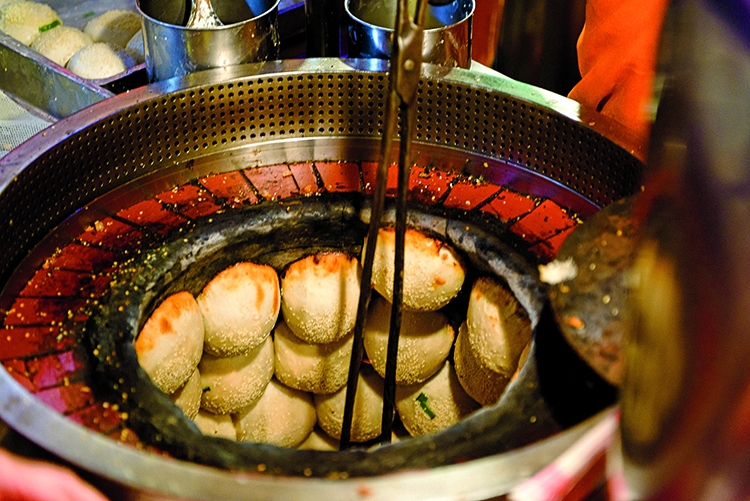The Raohe Street Night Market in Taipei, Taiwan’s capital city, is a long outdoor alley of shopping stalls on either side of a double central aisle devoted entirely to street food. The entrance is massive, painted bright red with hanging Chinese lanterns—a thousand-watt version of the Arc de Triomphe.
The most popular food stall sits at the entrance, selling pepper pork buns with scallions cooked in tandoor-style ovens, the doughy buns stuck onto the walls of the oven like naan. Each piping-hot bun is wrapped in paper, and orders are stuffed into plastic sacks. Hot, crusty, peppery and bright—at $2 each, we had seconds.
Other classic offerings included pork bone soup, grilled squid, rice balls, sweet sausages and rotisserie corn, but a few outliers stole the show: a pineapple-and-taro ice cream burrito served with shaved peanut brittle and cilantro; fresh-squeezed cane juice with ginger or lemon; and “fire and ice,” hot mochi balls filled with peanut or sesame paste, served atop a giant mound of blossom-water-sweetened crushed ice. Pig’s blood cake, served on a stick like a Popsicle, was coppery and unctuous. Stinky tofu, which you could smell 50 feet away, was chewy on the outside, fermented on the inside and served with soy sauce and pickled vegetables.
Taipei had proven it was the king of street food, but I was here to get a lesson in wok cookery, having selected three-cup chicken as my introduction. Years ago, I wrote a piece called “Throw Out Your Wok,” based on a cooking lesson from a Chinese cook based in San Francisco. She used a 12-inch nonstick skillet and said that all her friends in America had turned away from the wok as well. This made sense since a flat American stovetop is not ideal for a cone-shaped cooking vessel.
But over the years, doubts had crept in. New flat-bottomed woks are better suited to modern stovetops. Skillets often require batch cooking. Woks are made of thinner metal than skillets and heat quickly. And a conversation with wok expert Grace Young had left me uncertain about my opposition to the wok; she maintains that the wok produces unique flavors and aromas that she refers to as “the breath of the wok.” It was time to cook with a first-class wok expert to put my perhaps misguided notions to the test.

That expert was to be Kun-Yin Cheng, chef at Shin Yeh, one of the oldest white-tablecloth restaurants in town. The dining room was reminiscent of many Upper East Side Chinese restaurants in New York: simple, modern and accented with Asian motifs.
It was the kitchen, however, that grabbed my interest. It was a classic stainless-steel installation except for row sitting atop massive burners. The metal cooktop had spigots to clean the woks between deep-frying and stir-frying. Water ran constantly. There were two large metal containers of oil next to each station—one for fresh and one for used—and an extended metal shelf at each station to hold bottles of rice wine, which are used liberally in most recipes.
Before we began, my interpreter, Yun-Yun, explained that three-cup chicken was named after the three basic ingredients: soy sauce, toasted sesame oil and rice wine. This is not a literal one cup each; there is traditionally more soy sauce than sesame oil and more oil than rice wine. Yun-Yun then introduced me to Cheng—stocky, self-assured, friendly and proud of the four decades of wok cooking under his belt.

He began by ladling a few cups of cooking oil into the massive wok, heated it for just a minute, added a plate of skin-on, bone-in chicken chunks and fried them for a few minutes to crisp the skin. He scooped out the chicken, poured off the oil, added water to the wok and used a giant bamboo brush to clean it. He then added the aromatics (ginger, scallion, whole garlic cloves, chilies) and stir-fried them. Then the sauce: a mixture of soy sauce, toasted sesame oil, a liberal splash of rice wine and sugar.
The mixture came to a simmer, then he returned the chicken to the wok, cooking it in about 10 minutes while the sauce reduced and turned into a rich, dark brown coating. Simple enough and a wok tour de force: deep-frying, stir-frying and simmering, all in minutes.
And now for the first bite. In just a few minutes, the skin had crisped and the sauce reduced to a rich glaze. To be sure, I could smell the “breath of the wok,” an aromatic burst that wafts up from the just-cooked food. This put skillet stir-frying in its place. More horsepower and a bigger, better cooking vessel does mean better and faster.
Back at Milk Street, we were determined to use a wok for our three-cup chicken, but we needed to make a few changes.
Both the Chinese and Taiwanese love texture in their food—bone, cartilage and skin all contribute to the joy of eating. But hacking a chicken into 2-inch pieces was an unlikely first step for most of us here in the U.S. So we immediately tossed aside all credibility with our hosts and chose boneless, skinless chicken thighs cut into ½-inch strips.
Deep-frying the chicken in a wok made no sense for our choice of cut, so that step was eliminated. We used a simple cornstarch slurry so the sauce would better adhere to the chicken. (In Taipei, the larger chicken pieces could be cooked for a longer time, producing a reduced sauce that clings without the aid of cornstarch.)
Once we had our ingredients assembled and properly prepared, the rest of the process was quite similar to what I had seen Cheng execute in Taipei. And we loved the fact that no batch cooking or “in and out of the wok” steps were required. We started by cooking the chicken for five minutes without any stirring, then added the garlic, followed by more aromatics and the sauce mixture. Basil went into the wok off-heat.
My trip to Taipei left me with lots of memories, stinky tofu and pepper pork buns with scallions among them. But most of all, I came home questioning my former argument to throw out your wok.
Instead, I dug mine out and seasoned it. Then I stir-fried spinach in less than two minutes. Sometimes an old dog learns new tricks.




